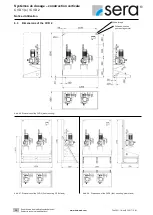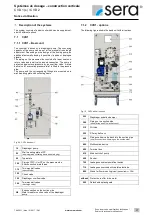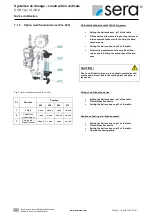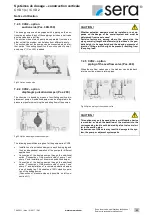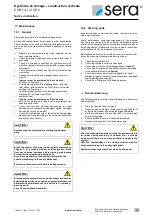
Systèmes de dosage – construction verticale
CVD 1 (s) / CVD 2
Notice d’utilisation
TA450-11 / fr/en / 01.2017 / PM
www.sera-web.com
Sous réserve de modifications techniques !
Subject to technical modifications!
49
Maintenance
10.1 General
All maintenance work is to be documented carefully.
All technical devices must be serviced in order to guarantee
proper function of the system. Generally valid statements can-
not be made as the maintenance schedule depends on various
factors.
•
Maintain the pumps according to the separate instruc-
tions (see data carrier).
•
Check the piping for tightness once a week, and repair, if
necessary.
•
Check the screwed connections for tightness every six
months or before starting the system after a longer period
of standstill.
•
Check the system visually, and check the pressure every
six months.
•
Check proper function of the leakage sensor every six
months
(option – must be evaluated by the customer)
by lifting the float switch
•
Check proper function of the leakage sensor solenoid
float switch (without admission WHG) every six months
by lifting the float switch.
To check proper function of the leakage sensor plate
electrode EP (with admission WHG)
see data sheet.
(option – must be evaluated by the customer)
•
Service the diaphragm overflow valve according to the
separate instructions.
•
Check the wires and electrical components for visual
damage (loose connections, damaged cables, damaged
devices etc.) every six months.
•
Check the preload pressure of the pulsation damper
(op-
tion)
once a week according to the separate instructions
and adjust, if necessary.
CAUTION !
Depressurize the system before starting maintenance
work.
CAUTION !
Rinse the system with water (water quality according to
Chapter 2) or a suitable medium until the system is free
from any chemical residues before starting maintenance
or repair work or replacing wearing parts.
Note the compatibility of the rinsing medium with the
chemical according to the safety data sheet.
Exothermic reactions must be avoided by all means!
CAUTION !
Disconnect the system from the power supply and secure
against being switched on again by appropriate measures,
before starting maintenance and repair work or replacing
wearing parts.
Consult a specialized electrician.
10.2 Wearing parts
sera
recommends to maintain the system twice a year to en-
sure proper operation.
Yearly maintenance comprises replacement of the gaskets
that come into contact with the chemical, diaphragms (yearly
or after 3,000 operating hours), suction and pressure valves of
the dosing pumps. Please see also the separate instructions
on the data carrier for maintenance of the parts.
Maintenance work which is carried out every six months com-
prises the checking of the complete dosing system.
•
Check the overall function.
•
Check the complete system for leakages.
•
Check proper function of the leakage sensor
(option)
.
•
Check proper function of the pulsation damper according
to the separate instructions
(option)
.
•
Check the wires and electrical components for visual
damage at regular intervals (loose connections, damaged
cables, damaged devices etc.).
•
Check the oil filling level of the dosing pumps.
Decommissioning
The following points must be observed when you decommis-
sion the system:
•
Drain the chemical from the pipes.
•
Rinse the pipes with water (water quality see Chapter 2)
or a suitable medium and empty the pipes afterwards.
•
Set the stroke length of the pumps to 50% to remove load
from the diaphragm.
•
Reduce preload pressure of the pulsation damper.
•
Disconnect the system from the power supply.
CAUTION !
After the chemical was drained, rinse the system with wa-
ter (water quality according to Chapter 2) or a suitable
medium until there are no more chemical residues in the
system!
Note the compatibility of the rinsing medium with the
chemical according to the safety data sheet.
Exothermic reactions must be avoided by all means!


